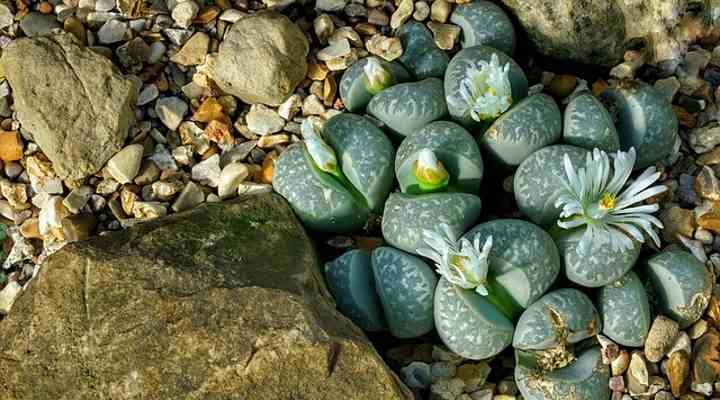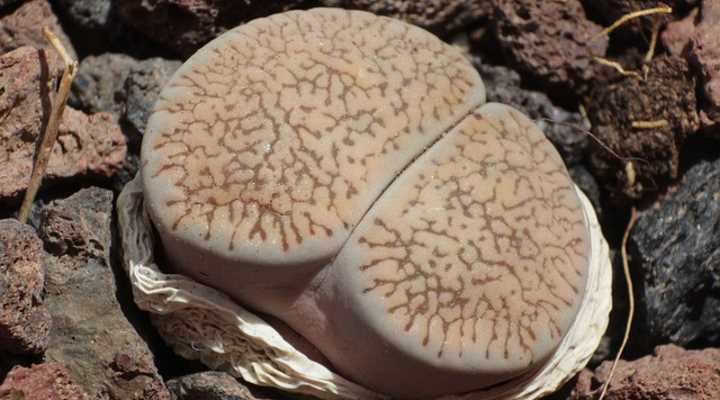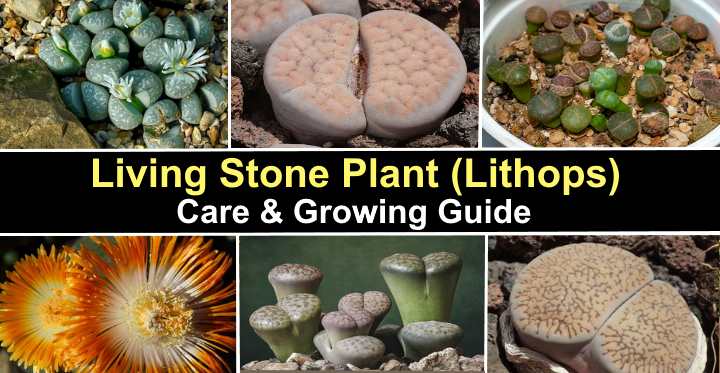Lithops is a succulent that can be maintained indoors and is sometimes referred to as living stone plant. The succulent resembles a little rock, pebble, or stone, hence the plant’s popular name is living stone. The two succulent leaves in a kidney bean shape are an unusual feature of lithops plants. A flower or a pair of new leaves emerge from the fissure between the two plump lithops leaves.
Succulent gardens often include lithops. Growing alongside other succulents, their stone-like appearance gives them fascinating characteristics. Lithops may develop into little clumps of fat, succulent plants over time. This is a full how-to guide for growing living stone plants at home. It is essential to understand the life cycle of lithops and how to water them correctly in order to attain optimum growth. Despite the fact that rock-like succulents are simple to cultivate.
How to Care for Lithops (Living Stone Plants)
The living stone plant should be grown in full sun and dry sandy soil to care for lithops indoors. The most vital aspect of lithops care is watering. Only in the autumn and spring does a living stone plant need water. Growth occurs best between 65°F and 80°F (18°C and 26°C).
What is the Living Stone Plant (Lithops Succulent)

Lithops is a flowering succulent that can live for a long time without water, thanks to its native environment in southern Africa’s hot, dry climate. This unusual succulent belongs to the ice plant family Aizoaceae and is known as Lithops in scientific and common terms. The singular and plural names for lithops are both given. Lithops succulents are also known as pebble plants, living stones, and split rocks since they resemble rocks. The botanical term alludes to the fact that it looks like a stone.
Lithops grow to be 1 inch (2.5 cm) tall and 1 to 3 inches (2.5 to 7.5 cm) broad in most cases. The succulent can survive for months without water thanks to the Lithops leaves, which store moisture. In climates where it never rains for years, certain lithops species grow. Some people have just a few rainy days each year.
The plant is mostly subterranean, with the exception of a few leaves. Only a few millimeters of the leaf tops protrude aboveground in the wild. Finding lithops growing in deserts is particularly difficult due to this growth feature. Succulents are difficult to distinguish from stones on the ground since they resemble tiny rocks or pebbles.
There are roughly 145 different types of lithops, nearly 40 species in total. When flowering or new leaves emerge, each species of lithops has a fissure between its fused leaves. Green, brown, creamy-white, blue-green, orangey-red, or dusty pink succulents are stone-like.
Succulent leaves have flat tops with intricate lines, dots, or colorful patterns painted on them. Lithops aaucampiae, Lithops dorotheae, ‘Karas Mountains Living Stone,’ Lithops karasmontana, and Lithops lesliei are some of the most vibrant living stone plants available.
Living Stone (Lithops) Flower

In late autumn and early winter, Lithops flowers produce daisy-like blooms that range in color depending on the species. The rays of slender petals that surround the yellow core of each star-shaped blossom. White, yellow, lilac, orange, and vivid pink are among the colors of Lithops flowers. On sunny days, living stone flowers emerge from the fissure and bloom in the afternoon.
How to Grow Lithops from Seeds

Lithops seedlings may be cultivated from seed with little trouble. Just scatter lithops seeds over a well-draining, moist potting soil and you’re done! Cover the seeds with a thin layer of sand. To retain heat and moisture, spray a fine mist of water on the earth and cover it with plastic. Keep the soil just moist and place it on a sunny windowsill.
The lithops seeds should have germinated after 12 weeks. Afterwards, to continue growing, remove the plastic cover and transfer the seedlings to their own pots. When the earth is completely dry, only water the live stone plants. Plant division is another technique of lithops spread.
Lithops Growth Cycle

Lithops develop a new pair of leaves after the blooming process is over, while the previous ones perish. Overwatering or watering lithops in the incorrect season, for example, is a common blunder. Knowing how lithops develop will help you keep them healthy.
Lithops plants bloom in the fall after they have been growing for three years. A seed capsule forms in the center of the flower when it has faded. The capsule will open and release seeds if there is any moisture in the middle. New succulent leaves appear beneath the plant after it blooms. Once the new leaves draw moisture from the old ones, the old leaves will start to wilt throughout the winter. The new, fat leaves will be visible in the spring. In the summer, a lithops plant is dormant.
Early in the autumn, when the plant resumes growth and starts to bloom, is the only time lithops needs water throughout its yearly lifecycle. After the previous leaves have withered and died in the spring, and the two new ones have started to develop, Lithops plants should grow for 40 to 50 years if they are properly watered.
Living Stone Plant (Lithops) Care Guide
Let’s take a closer look at how to develop a collection of alive stone plants in your home or tropical garden.
How to Water Lithops
Water lithops are only twice a year cleaned to stay healthy. When the growth resumes in the autumn and the succulent starts to bloom, water lithops are ready. The second occurrence is when the new leaves emerge in the spring. Don’t water lithops when they’re not in bloom. The health of a lithops plant depends on the use of proper watering methods. Soak the soil in the pot until it exits through the drainage holes to water the succulent. Once the soil has dried out completely, typically after two weeks, water your lithops plants again.
The yearly growth cycle and seasonal habits of watering lithops determine how often it is watered. During the summer, lithops, for example, are inactive and do not need watering. After that, watering the succulent bloom and new foliage in the autumn and spring aids them to develop. During the winter, you must also prevent lithops from being watered. If the leaves of a lithops plant seem wrinkled and drying out, watering it in the summer is pointless. In this case, just give a little amount of water in the morning.
What makes you think that watering lithops in the winter is a bad idea? Its proliferation habits are to blame for this response. During the winter, new leaves absorb moisture from older ones. The previous leaves will continue to try to develop if you water the plant at this time, resulting in both sets of leaves dying. If the lithops get enough moisture from a humid environment, it’s good to remember that you may never need to watering them.
Tips on watering lithops correctly
When it comes to watering live stone plants, here are a few helpful hints:
- Root rot can be caused by overwatering a lithops.
- Plants should only be watered occasionally and at the times of their yearly development.
- Throughout the summer and winter, allow lithops to dry out.
- In the autumn, when the fissure starts to split, begin watering.
- After the previous leaves have withered completely in the spring, resume watering.
- Watering lithops in the same way as cactus plants is done.
Lithops Light Requirements

Lithops require four to five hours of direct sunlight every day in order to thrive. South-facing windows or east-facing windowsills are the ideal locations to cultivate lithops indoors. The growth of lithops plants is influenced by insufficient sunlight, which causes yellow or stretched leaves.
Inadequate sunlight is one of the reasons lithops die. After the long winter months, it’s important to remember that lithops may need adjustments to bright sunlight. Therefore, before adding a lithops to full sun in early spring, gradually enhance complete sun exposure. As a result, you’ll prevent tension and burning of the fleshy leaves.
The Best Soil for Growing Lithops
Cactus soil mix is the best growing medium for living stone plants. Combine one part conventional houseplant soil with two parts perlite, coarse sand, or crushed gravel to create a lithops soil mixture. Soil improvement with coarse, inorganic substance aids healthy development by improving drainage.
Lithops development may be harmed by too much moisture retention. Roots rot in damp soil, enabling insects to flourish. Lithops plants grow in sandy deserts and rocky ground in their natural habitat. Pick a pot that seems bigger than necessary when choosing a pot for lithops. Lithops need a lot of room to develop their extensive root systems. Also, to prevent soggy soil, inspect the pot for drainage holes.
Living Stone Plant Temperature Requirements

Lithops prefer temperatures of 65°F to 80°F (18°C to 26°C) and need plenty of sunlight. Lithops prefer a temperature range of 65°F to 80°F (18°C to 26°C). Lithops need a minimum temperature of 55°F (12°C), but they will perish if the temperature drops below freezing.
If you live in USDA zone 10 or 11, you can grow lithops outside in a succulent garden. You may cultivate live stone plants and rock succulents throughout the winter if outdoor temperatures do not drop below 55°F (12°C). Lithops, on the other hand, flourish best indoors in zones 9 and lower.
How to Fertilize Lithops (Living Stone Plant)
Lithops prefer poor soil and don’t need extra fertilizer. Lithops grow on sandy soil in their natural environment, devoid of any organic matter. If you want to encourage blooming, though, you can add a highly diluted cactus fertilizer in late summer. The use of a high-potassium, low-nitrogen fertilizer is recommended.
How to Propagate Living Stone Succulents
Division or seeding are two methods to propagate lithops, but both take a long time. If you have a group of lithops that takes several years to grow, you may propagate them by root division. Remove the clump from the pot and gently dust down the roots in order to spread the living stones.
Next, locate places to cut the roots, ensuring that at least one plant is connected. Lithops need a substantial quantity of taproot linked to each pair of leaves in order to propagate successfully.
Repotting Living Stone Plants

When you propagand lithops, they simply need to be repotted. Make a fresh, well-draining cactus mixture to repot a lithops. Then, place the live stone with the leaf ends protruding 0.5 inch (1.2 cm) from the top of the soil. When repotting, avoid disturbing the taproot too much, since it is necessary for the plant’s development.
In the same pot, living stone plants can live up to 20 years. Choose a 5″ (13 cm) deep terracotta pot for repotting. This allows the plant’s roots to expand freely. You may embellish the soil with genuine pebbles, gravel, or stones to create a natural ambience for your living stone succulents to produce an attractive succulent garden in a pot.
Pests Affecting Lithops Care
Living stones keep most houseplant pests at bay. Spider mites, on the other hand, are the most prevalent kind of bug that affects plant growth. The dry conditions that lithops need are ideal for Spider mites to grow. Pale white spots or small web-like strands on the plant or between the leaves are signs of spider mites.
Use neem oil to eliminate white scar spots on the meaty leaves and evidence of webbing if you notice them. Add 2 tsp. of oil to the mix if you’re not sure about it. 1 tsp. of neem oil In a spray bottle, combine 1 quart (1 liter) of water and Castile soap. To get rid of spider mites, spray lithops once a week. Succulents like lithops may be infested by mealybugs, aphids, or thrips on rare occasions.
Diseases Affecting Lithops Growth
Root rot, which is caused by overwatering, is the only plant disease affecting lithops. Roots rot and leaves crack as a result of excess moisture in the soil. You should not have any succulent plant disease issues if you water lithops in line with its seasonal habits and only when the soil is dry.
Is Lithops Toxic?
Dogs and cats will not become ill from Lithops. Living stone plants are included on the ASPCA’s list of non-toxic plants for pets. Furthermore, lithops are listed as a safe plant by the University of California.
FAQs About Lithops and Their Care

What are blue lithops?
Blue lithops dubbed “Blue Witchford Lithops” by some on-line merchants are available for purchase. The stones range in hue from light to dark blue. Sadly, the majority of blue lithops sold online are photoshopped to make them appear blue.
What to do about overwatered lithops?
It’s critical to dry the roots of an overwatered lithops as soon as feasible to avoid them from dying. Remove any mushy roots and remove the small living stone plants from the soggy soil. Let the roots dry for a few days before watering. Lithops should be replanted in well-draining sandy soil if there is no damage to the leaves.
Vertical lines on the sides of the fleshy, wrinkly leaves are a sign of overwatered lithops. Only water the plant twice a year, in early fall and early spring, to prevent further damage.
How long does it take for lithops to split?

It takes one or two months for a Lithops to develop a flower and split. It’s critical to refrain from watering the plant throughout the splitting process while you’re away.
Why are my lithops wrinkly?
Lithops, like most succulents, get wrinkly if they don’t get enough water. Without water, the live stone plants can survive for many weeks or months. Yet, certain species demand greater watering than others. The wavy lines across the leaves will tell you if a lithops needs watering. When a lithops plant dies and before new leaves develop, its leaves naturally shrink and wrinkle. Wrinkled lithops leaves aren’t a concern if it’s early in the growing season.
How can I tell if my lithops are dying?
Yellowing leaves, wilting, signs of shriveling, and mushy leaves near the soil line are all indications that a lithops plant is stressed and dying. Overwatering is the most common cause of death in lithops. A lithops plant, on the other hand, can be killed by insufficient sunlight. Therefore, protect your lithops from becoming too wet or too exposed to the sun.
